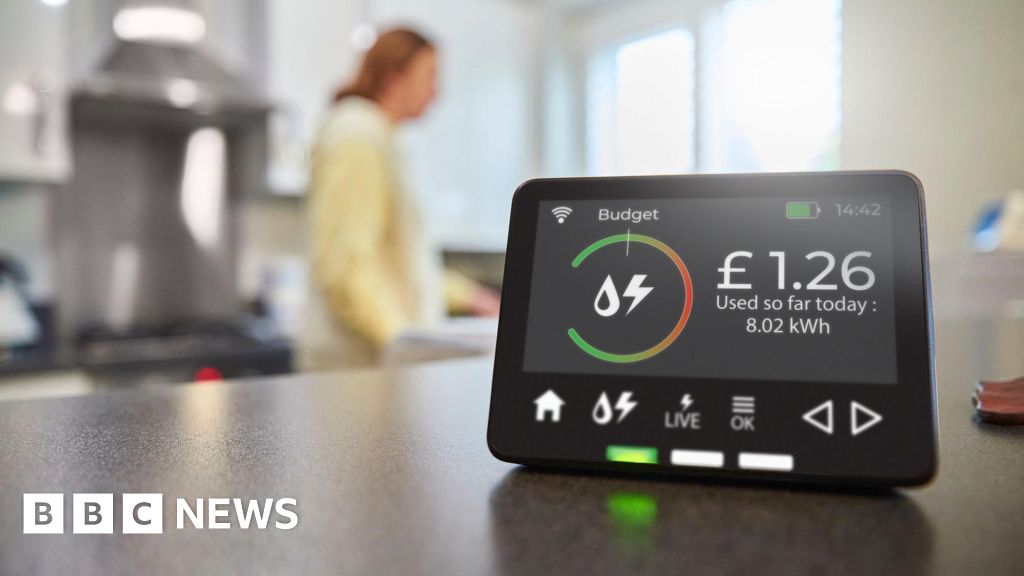Business
Households to be offered energy bill changes, but unlikely to lead to savings

Kevin PeacheyCost of living correspondent
 Getty Images
Getty ImagesEvery household will be offered a low standing charge deal by the end of January, under new plans, but the cost of overall energy bills is unlikely to fall.
Regulator Ofgem has announced all suppliers in England, Scotland and Wales will offer at least one tariff in which standing charges are lower but customers then pay more for each unit of energy used.
The move comes after those who use relatively little gas and electricity argued they have no control over the fixed daily charges, which cover the cost of connecting to a gas and electricity supply.
However, consumer champion Martin Lewis said the policy was “disappointing” and charities warned it did not address the issue of high bills.
Standing charges pay for the cost of transporting energy to people’s homes, security of the supply, investment in the energy network and some bill support schemes.
From 1 October, the charges will typically cost 53.68p a day for electricity and 34.03p a day for gas for those paying by direct debit.
However, these fees vary depending on where billpayers live. In North Wales and Merseyside, the cost will be nearly 70p a day for electricity, for example.
Ofgem has been considering how to change the bill payments system after widespread concern and backlash from households.
When bills were at a peak in the winter of 2022, many people slashed their energy use but still had to pay the standing charge element of the bill, regardless of how much gas or electricity was used.
While Ofgem’s plans will enable customers to take up a deal where standing charges are lower, the savings are likely to be limited due to such tariffs having higher rates for energy usage.
“Plans to offer a lower standing charge may provide more choice to consumers, but won’t bring down people’s bills,” said Gillian Cooper, director of energy at Citizens Advice.
Ofgem said costs covered by standing charges must be paid somehow, and so has said it could only move them to another part of the bill.
The announcement of the plans comes as energy bills for millions of people on tariffs which vary with Ofgem’s price cap are rising by 2% in October.
Rising standing charges are part of that, with the fees typically rising by 4% for electricity and 14% for gas.
‘More choice’
“We have carefully considered how we can offer more choice on how they pay these fixed costs, however we have taken care to ensure we don’t make some customers worse off,” said Tim Jarvis, from Ofgem.
The regulator’s latest proposals are less radical than previously considered, and it would also require tariffs to have a minimum usage level.
Under its plans, now subject to consultation:
- All suppliers in England, Scotland and Wales must offer a low standing charge tariff to customers. Some providers already offer this as an option, but it would be universal
- All billpayers will have the choice to move to such a tariff by the end of January
- The new tariffs will be available to customers irrespective of how they pay their bill, such as by direct debit or quarterly on demand
“The costs covered by the standing charge ultimately must be paid. We cannot remove these charges, we can only move costs around,” added Mr Jarvis.
“These changes would give households the choice they have asked for, but it’s important that everyone carefully considers what’s right for them as these tariffs are unlikely to reduce bills on their own.”
People who cut their energy use should see a bigger reduction in bills than would be the case without these changes, he said.
Suppliers will be able to decide whether to also offer zero standing charge tariffs, with much higher unit rates.
Rising cost
Many charities say that rather than shifting the fee onto another part of the bill, more should be done to help those struggling to pay.
“With October’s price hike just around the corner, lower standing charge tariffs will not help the millions of households bracing themselves for yet another winter of unaffordable energy bills,” said Ms Cooper, of Citizens Advice.
Campaigners are also concerned that more tariffs could create greater confusion.
Mr Lewis, the founder of Money Saving Expert, said the “disappointing” plan seemed to be “significantly watered down” from earlier proposals.
“I get more complaints about standing charges than anything else in energy bills,” he said. “I worry Ofgem has picked an easy route to appease suppliers’ concerns, that doesn’t help the most vulnerable.
“I suspect if it goes ahead like this, not enough people will switch and they’ll say ‘it wasn’t worth it.'”
Dhara Vyas, from Energy UK, which represents suppliers, said it was hard to see how the move warranted the potential cost and disruption.
“Ofgem admits [this] will only be temporary and merely move costs around on the bill, so delivering a limited benefit to customers,” she said.
The plans will now go to consultation before a final decision is made.
Business
Shona Robison may ‘potentially revisit’ Scottish taxes in response to UK Budget

Scotland’s Finance Secretary says she may have to “potentially revisit” her tax plans amid reports the Chancellor will increase income tax in the Budget this month.
Shona Robison said the Scottish Government had a “very limited” set of levers to respond if Rachel Reeves makes the tax decision on November 26.
The Fraser of Allander Institute has estimated a 2p income tax hike in the UK Budget could cut Scotland’s funding by £1 billion because of the way the fiscal framework operates.
Ms Robison has requested an urgent meeting with the Chancellor, saying Ms Reeves should ditch her fiscal rules and instead deliver investment “to grow the economy and support people with the cost of living”.
Speaking to BBC Scotland’s Sunday Show, Ms Robison said the fiscal framework does not take account of changes to national insurance – another levy the Chancellor is reportedly considering changing.
The fiscal framework governs the public money coming to the Scottish Government, but Ms Robison said the system is now in “uncharted territory” as it did not envisage simultaneous changes to both income tax and national insurance.
Ms Robison was asked if she would raise Scottish income tax rates in response to any income tax increase in the Chancellor’s Budget.
She said: “I’m not going to set out here today what our plans for income tax are when we don’t know what we’re going to face on the 26th…
“If we end up in this scenario, then the levers available to us are very limited.
“Unless there is flexibility given to us through the fiscal framework – which would be my first ask, that we need to have that flexibility.
“Because we don’t want to raise taxes, we had already set out in the tax strategy that we want to see that stability till the end of the Parliament.
“But in the event of unforeseen exceptional circumstances, clearly we would have to potentially revisit that.”
Under the devolution settlement, the Scottish Government has powers to adjust income tax rates north of the border.
An HM Treasury spokesperson said earlier: “Our record funding settlement for Scotland will mean over 20% more funding per head than the rest of the UK.
“We have also confirmed £8.3 billion in funding for GB Energy-Nuclear and GB Energy in Aberdeen, up to £750 million for a new supercomputer at Edinburgh University, and are investing £452 million over four years for City and Growth Deals across Scotland.
“This investment is all possible because our fiscal rules are non-negotiable, they are the basis of the stability which underpins growth.”
Business
Pakistan’s manufacturing sector slump: Private investment plunges 46%; experts warn of long-term industrial decay – The Times of India

Pakistan’s manufacturing industry, once considered a key driver of economic growth and employment, is undergoing one of its worst downturns in recent history. The sector has seen a steep 46 per cent fall in private investment over the past six years, raising fears of long-term stagnation among economists and industrial experts.According to The Express Tribune report cited by news agency ANI, private investment in manufacturing dropped from PKR 706 billion in FY2018–19 to just PKR 377 billion in FY2024–25, marking the weakest phase of industrial growth in more than a decade. Ali Imran Asif, Senior Executive Committee Member of the Lahore Chamber of Commerce and Industry (LCCI), warned that the current level of investment was “not enough to even replace depreciating machinery,” suggesting a deep erosion of Pakistan’s industrial foundation.“We are not dealing with a short-term dip; we are watching our industrial base disintegrate,” Asif said, as per The Express Tribune. He stressed that without structural reforms focused on productivity, innovation, and competitiveness, the country could face prolonged industrial paralysis.The combined contribution of the manufacturing and mining sectors to Pakistan’s GDP has remained stagnant at around 13.2 per cent over the past six years. Frequent policy changes, high energy costs, and volatile currency movements have severely affected export-oriented sectors such as textiles, leather, and engineering goods. Large-scale manufacturing output fell 1.5 per cent in FY25, reversing the 0.92 per cent growth recorded in FY24.In contrast, neighbouring economies like India and Bangladesh have maintained strong industrial growth supported by stable policies and export diversification. Economist Shahid Saleem noted that Pakistan’s slump is not merely the result of high interest rates but also reflects policy inconsistency and eroding investor confidence. Import restrictions and weak domestic demand have forced many factories to run below capacity, he added.Experts, as cited by ANI, warned that unless Pakistan swiftly formulates a credible industrial revival plan and ensures policy stability, the manufacturing sector’s decline will deepen further, undermining exports, employment and broader economic resilience.
Business
More than 1,000 flights cancelled as US air traffic cuts enter second day

 Getty Images
Getty ImagesMore than 1,400 flights to, from, or within the US were cancelled on Saturday after airlines were told this week to cut traffic during the federal government shutdown.
Nearly 6,000 flights were also delayed, down from over 7,000 delays on Friday, according to flight tracker FlightAware.
The Federal Aviation Administration (FAA) announced earlier in the week that it would be reducing air travel capacity by up to10% at 40 of the nation’s busiest airports as air traffic controllers, who are working without pay during the shutdown, report fatigue.
Republicans and Democrats remain divided over how to end the impasse in Congress as the shutdown, which began 1 October, continues.
Saturday marked the 39th day of the longest shutdown in history as Republicans and Democrats still have not agreed on a funding resolution to reopen the government.
Senators are in Washington over the weekend for bipartisan negotitations aimed at ending the shutdown, which is beginning to be felt by more and more Americans amid cuts to food aid payments and the flight disruptions.
In a statement on Saturday, American Airlines urged “leaders in Washington, D.C., to reach an immediate resolution to end the shutdown”.
New Jersey’s Newark Liberty International Airport was experiencing some of the longest wait times. As of Saturday afternoon, arrivals to the airport were delayed by an average of more than four hours, while departures from the airport were delayed by an average of 1.5 hours, according to the FAA.
The airports with the most cancelled flights on Saturday, both to and from the location, were Charlotte/Douglas International, Newark Liberty International, and Chicago O’Hare International, according to FlightAware.
Departures to John F Kennedy International, Hartsfield-Jackson Atlanta International, and La Guardia were delayed by nearly three hours, over 2.5 hours, and about an hour, respectively, the FAA reported as of Saturday afternoon.
With the Thanksgiving holiday approaching on 27 November, it’s one of the busiest travel seasons of the year in the US.
It’s not just commercial flights that have been affected. Restrictions on private jets are also in place, Secretary Duffy said in a Saturday post on X.
“We’ve reduced their volume at high traffic airports — instead having private jets utilize smaller airports or airfields so busy controllers can focus on commercial aviation,” Duffy wrote. “That’s only fair.”
And things will likely get worse in the coming days as the FAA increases the percentage of cancelled flights.
On Thursday, the agency announced that the flight reductions would be gradual, starting at 4% of flights on Friday before rising to 6% by 11 November, 8% by 13 November, and the full 10% by 14 November.
The FAA said the cuts were necessary to maintain safety as air traffic controllers have been overworked during the shutdown.
As essential workers, the controllers are required to continue working without pay, and as a result, many have called out sick or taken on second jobs to afford necessities, unions say.
The controllers are just some of the 1.4 million federal workers who have either been working without pay or been put on forced during the shutdown.
Another factor impacting air travel is that most of the Transportation Security Agency (TSA) 64,000 agents are also not being paid while the shutdown is in place.
During the previous government shutdown, under US President Donald Trump in 2018, it was found that up to 10% of TSA staff chose to stay at home rather than work for free.
-

 Tech1 week ago
Tech1 week agoDisney content has gone dark on YouTube TV. Here’s what customers should know
-

 Tech1 week ago
Tech1 week agoGear News of the Week: Withings Launches Its Pee Scanner, and Samsung Shows Off a Trifold Phone
-

 Sports1 week ago
Sports1 week agoTudor’s Juve exit means McKennie must prove himself all over again
-

 Business1 week ago
Business1 week agoAndy Jassy Reveals Real Reason Behind Amazon 14,000 Job Cuts — And It’s Not AI
-
Sports1 week ago
Ravens are back in the hunt after two straight wins and Lamar Jackson’s return
-

 Tech1 week ago
Tech1 week agoKeep Tabs on Your Pets and Kids With the Best Indoor Security Cameras
-

 Fashion1 week ago
Fashion1 week agoIndia’s Raymond Lifestyle Ltd’s Q2 FY26 revenue rises 8% to $211.5 mn
-

 Politics1 week ago
Politics1 week agoPolitical violence kills almost 300 since Hasina’s fall: rights group




